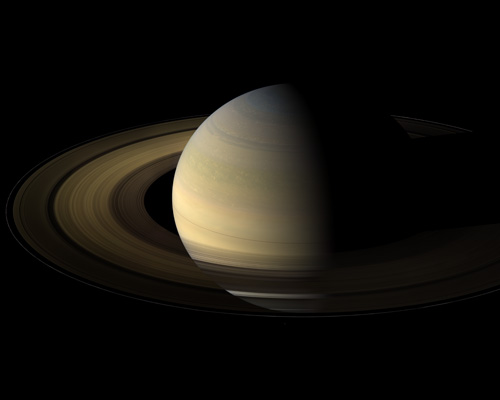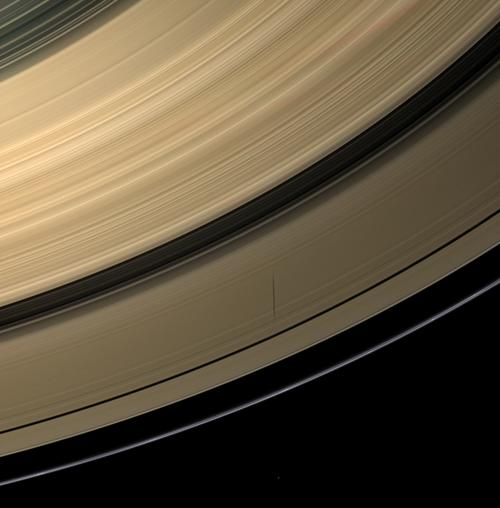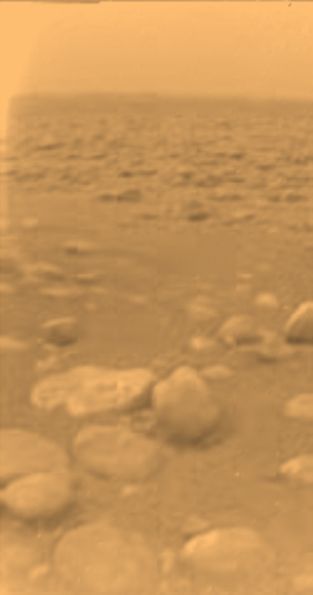Technical Data:-
| Diameter | 120,200 km |
| Average Distance from Sun | 1,427 million km |
| Mass | 5.68 x 1026 kg |
| Size Compared to Earth (Diameter) | 9x |
| Gravity compared to Earth | 0.93x |
| Cloud-Top Temperature | -180°C |
| Length of Day | 10 hours 14 mins |
| Length of Year | 29.46 Earth years |
| Eccentricity of Orbit | 0.056 |
| Moons | 30+ |
| Density | 0.70gm/cm3 |
| Atmosphere | Hydrogen - 94% Helium - 6% Traces of Methane, Ammonia & Water Vapour |
................................................................................
................................................................................
Brief History:-
Galileo Galilei discovered Saturn's rings in 1610 and it was in 1659 that Chistiaans Huygens realised they weren't physically attatched to Saturn. Then in 1676 Italian-French astronomer Jean Dominique Cassini discovered the Cassini division in the rings. The first pictures of Saturn's polar regions were taken in 1979 by the Pioneer 11 and a year later, in 1980, Voyager took 17,500 colour pictures of the planet, measured wind speeds in Saturn's equatorial region and measured Titan's size. Voyager 2 passed even closer than Voyager in 1981. In 2004 the Cassini spacecraft arrived into orbit around Saturn, and in 2005 the Huygens probe landed on the surface of Titan.
................................................................................
................................................................................
Saturn (named after the Roman God of Agriculture) has a diameter of 120,000 km, which makes it the second largest planet in the Solar System. Similar in some respects, and the only planet comparable in size to Jupiter, Saturn nonetheless has several features which make it unique in its own right, and which have intrigued astronomers from Galileo, could not make sense of its ring system when he first observed the planet through his telescope in 1610, right up to the present day, as the latest data sent back from spacecraft continue to throw up surprises and open new questions.
Few would dispute Saturn's claim to be the most picturesque planet in the Solar System, with its magnificent system of rings and its smooth yellow texture. Its colour stems from the elemental composition of the thick atmosphere which envelopes the planet, but beneath the atmosphere it actually has an ocean of molecular liquid Hydrogen which enfolds a shell of ionised, so-called 'metallic' Hydrogen. Another distinctive feature of Saturn, which can be seen even through a simple telescope, is that it is flattened at its poles and bulges outwards at its equator, like a flattened football. This is because the planet spins so fast that the material around its equator is flung outwards, with enough force to cause the equator to bulge by around 10% more than its poles.
The most striking feature of Saturn is to most people the series of rings which encircle it. They were first spotted in 1610 by the great Italian astronomer Galileo Galilei, who was mystified as to why Saturn appeared to have two circles, or 'cup holders' on either side of it. It wasn't until a few decades later, in 1659, that the Dutch astronomer Christiaan Huygens discovered that they were actually seperate from the planet, and must therefore be encircling it. Just 16 years later, Cassini discovered the'Cassini division' - a small gap in the middle of the ring system between what are now termed the A and B rings, the A ring being the innermost one and the B ring being further out. The reason for this 4,800km-wide gap in the rings is that Saturn's moon Mimas orbits at this distance from the planet, and has 'swept up' the rocks which form the ring system which surrounding it. The Cassini division is clearly visible on any detailed picture of Saturn and its rings, such as the one at the top of this page. Subsequent observations have also found several more seperate rings around Saturn, with the outermost being termed the F ring..
Though they look solid from a distance, the rings are actually quite insubstantial and are made up of rocks and blocks of water ice varying in size from a few tens of metres to a few micrometres (0.000001 metre) in diameter. The overall effect made by all of these small rocks around Saturn is quite remarkable, especially given the typical thickness of the main rings is only about 10 metres, and the ring system unique on this scale in our Solar System. The thinness of the rings is all the more remarkable given they extend outwards to hundreds of thousands of kilometres, roughly to the same distance from Saturn's surface as the Moon is to the Earth's.
Much of our knowledge about Saturn's rings comes from data sent back from the Voyager 1 and 2 spacecraft back in the 1980s - our measurements of their thickness and composition for instance. More recently, the Cassini spacecraft has revealed hitherto unknown detail about its structure, for instance the presence of vertical formations in some of the rings, with clumps of material being observed to be as much as 3km tall in some places, suprising bearing in mind the typical rings thickness of 10 metres or so!
As with the other gas planets, Saturn has a strong magnetic field - around 578 times stronger than Earth's in fact, though still much weaker than Jupiter's. Its magnetosphere is large enough to encompass its entire ring system, as well as most of its known satellites. The Hubble Space Telescope has shown that Saturn has aurorae (or Northern & Southern Lights) similar to those visible on Earth, where charged particles from the Solar Wind become trapped by a planet's magnetic field and collide with molecules in the planet's atmosphere, above the poles, though later observations from the Cassini spacecraft have shown that Saturn actually has multiple aurorae, some of which, like Jupiter's, seem to be completely unaffected by the Solar Wind.
Saturn's atmosphere is rather like Jupiter's except that it is colder and the cloud layers are thicker. The chracteristic coloured bands which are very visible on Jupiter are fainter on Saturn, and have a tendancy to become wider in the equatorial regions. Like Jupiter, it also seems to have big oval-shaped storms raging in its atmosphere, though none on the scale of Jupiter's Great Red Spot. In addition to the Hydrogen and Helium which make up the bulk of the ingredients in Saturn's atmosphere, there are also traces of water, methane and ammonia present.
The core of Saturn is also thought to be very similar to that of Jupiter, small and rocky, and surrounded by a layer of liquid metallic Hydrogen beneath another layer of molecular Hydrogen. There are also traces of various ices present.
The temperature of Saturn's core is thought to be at around 12,000°K, and actually radiates more energy than it recieves from the Sun. This is most likely due to the same process of gravitational compression present in Jupiter, which provides the planet with heat. Around the equator, winds sweep about at an impressive 1,800 km/h, over four times as fast as the fastest winds on Earth. Saturn is the least dense of all the planets, with its mass so spread out that on average it is less dense than water.
Saturn has over 30 satellites, plus probably many others as yet undiscovered. Saturn's first-discovered 18 moons are: Pan, Atlas, Prometheus, Pandora, Epimitheus, Janus, Mimas, Enceladus, Thethys, Telesto, Calypso, Dione, Helene, Rhea, Titan, Hyperion, Iapetus and Phoebe. The most important one is Titan and scientists hope to find out what the Earth was like long ago through studying it. It is also a rather large moon, being bigger than Mercury, and second in moonly size only to Jupiter's moon Ganymede in our Solar System. Titan is the only moon in the Solar System to have an atmosphere. In 2005 the Cassini spacecraft dropped the Huygens lander onto the surface of Titan, which beamed back readings and images during its descent through the Titanian atmosphere and even from the surface of the moon, revealing a rocky landscape. The mission also confirmed the presence of day clouds, and lakes of ethane and methane on the moon.
More information about the joint NASA-ESA Cassini-Huygens mission can be found on its mission website, and makes for a fascinating read. At the time of writing, the Cassini mission is scheduled to continue until around 2012, and scientific studies and discoveries about Saturn and its moons are currently in full swing.
Few would dispute Saturn's claim to be the most picturesque planet in the Solar System, with its magnificent system of rings and its smooth yellow texture. Its colour stems from the elemental composition of the thick atmosphere which envelopes the planet, but beneath the atmosphere it actually has an ocean of molecular liquid Hydrogen which enfolds a shell of ionised, so-called 'metallic' Hydrogen. Another distinctive feature of Saturn, which can be seen even through a simple telescope, is that it is flattened at its poles and bulges outwards at its equator, like a flattened football. This is because the planet spins so fast that the material around its equator is flung outwards, with enough force to cause the equator to bulge by around 10% more than its poles.
 |
| Saturn at Equinox from the Cassini spacecraft Credit: NASA/JpL |
Though they look solid from a distance, the rings are actually quite insubstantial and are made up of rocks and blocks of water ice varying in size from a few tens of metres to a few micrometres (0.000001 metre) in diameter. The overall effect made by all of these small rocks around Saturn is quite remarkable, especially given the typical thickness of the main rings is only about 10 metres, and the ring system unique on this scale in our Solar System. The thinness of the rings is all the more remarkable given they extend outwards to hundreds of thousands of kilometres, roughly to the same distance from Saturn's surface as the Moon is to the Earth's.
 |
| Saturn's rings seen by the Cassini spacecraft. Credit: ESA/NASA/JpL |
As with the other gas planets, Saturn has a strong magnetic field - around 578 times stronger than Earth's in fact, though still much weaker than Jupiter's. Its magnetosphere is large enough to encompass its entire ring system, as well as most of its known satellites. The Hubble Space Telescope has shown that Saturn has aurorae (or Northern & Southern Lights) similar to those visible on Earth, where charged particles from the Solar Wind become trapped by a planet's magnetic field and collide with molecules in the planet's atmosphere, above the poles, though later observations from the Cassini spacecraft have shown that Saturn actually has multiple aurorae, some of which, like Jupiter's, seem to be completely unaffected by the Solar Wind.
 |
| Surface of Titan, from the Huygens probe Credit: ESA/NASA/JpL |
The core of Saturn is also thought to be very similar to that of Jupiter, small and rocky, and surrounded by a layer of liquid metallic Hydrogen beneath another layer of molecular Hydrogen. There are also traces of various ices present.
The temperature of Saturn's core is thought to be at around 12,000°K, and actually radiates more energy than it recieves from the Sun. This is most likely due to the same process of gravitational compression present in Jupiter, which provides the planet with heat. Around the equator, winds sweep about at an impressive 1,800 km/h, over four times as fast as the fastest winds on Earth. Saturn is the least dense of all the planets, with its mass so spread out that on average it is less dense than water.
Saturn has over 30 satellites, plus probably many others as yet undiscovered. Saturn's first-discovered 18 moons are: Pan, Atlas, Prometheus, Pandora, Epimitheus, Janus, Mimas, Enceladus, Thethys, Telesto, Calypso, Dione, Helene, Rhea, Titan, Hyperion, Iapetus and Phoebe. The most important one is Titan and scientists hope to find out what the Earth was like long ago through studying it. It is also a rather large moon, being bigger than Mercury, and second in moonly size only to Jupiter's moon Ganymede in our Solar System. Titan is the only moon in the Solar System to have an atmosphere. In 2005 the Cassini spacecraft dropped the Huygens lander onto the surface of Titan, which beamed back readings and images during its descent through the Titanian atmosphere and even from the surface of the moon, revealing a rocky landscape. The mission also confirmed the presence of day clouds, and lakes of ethane and methane on the moon.
More information about the joint NASA-ESA Cassini-Huygens mission can be found on its mission website, and makes for a fascinating read. At the time of writing, the Cassini mission is scheduled to continue until around 2012, and scientific studies and discoveries about Saturn and its moons are currently in full swing.
